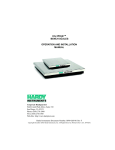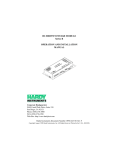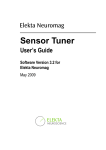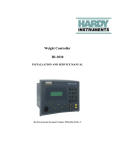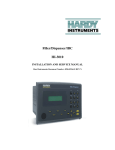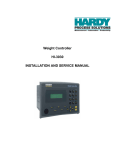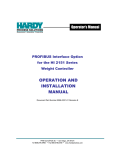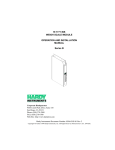Download hi ws100 configuration software operation and installation manual
Transcript
HI WS100 CONFIGURATION SOFTWARE OPERATION AND INSTALLATION MANUAL Corporate Headquarters 3860 Calle Fortunada San Diego, CA 92123-1825 Phone: (858) 278-2900 FAX: (858) 278-6700 Web-Site: http://www.hardyinst.com Hardy Instruments Document Number: 0596-0241-01 REV A-1 Copyright November 1999 Hardy Instruments, Inc. All Rights Reserved. Printed in the U.S.A. (941028) 1-2 Table of Contents Table of Contents TABLE OF CONTENTS - - - - - - - - - - - - - - - - - - - - - - I TABLE OF ILLUSTRATIONS - - - - - - - - - - - - - - - - - - - I CHAPTER 1 - OVERVIEW - - - - - - - - - - - - - - - - - - - - - 1-1 A Brief Description of Chapter 1 - - About Hardy Manuals - - - - - - - Description - - - - - - - - - - - - - C2® Calibration - - - - - - - - - - IT - - - - - - - - - - - - - - - - - Weighing System Tests - Optional - - - - - - - - - - - - - - - 1-1 - 1-2 - 1-2 - 1-3 - 1-3 - 1-4 CHAPTER 2 - REQUIREMENTS - - - - - - - - - - - - - - - - - - 2-1 General Introduction to Chapter 2 - - - - - - - - - - - - - - - Operating System Requirements - - - - - - - - - - - - - - - - Minimum Hardware Requirements - - - - - - - - - - - - - - - Software Requirements - - - - - - - - - - - - - - - - - - - - RSLogix OR EQUAL (FOR REMOTE MODE OPERATION ONLY) - 2-1 - 2-1 - 2-1 - 2-1 - 2-1 CHAPTER 3 - INSTALLATION - - - - - - - - - - - - - - - - - - - 3-1 Installing the Hardy Instruments Configuration Software - - - - - - - 3-1 Installation of RSLOGIX - - - - - - - - - - - - - - - - - - - - - - 3-1 Installation of RSLINX or RSLINX Lite - - - - - - - - - - - - - - - 3-1 Wiring Diagram for the HI 215IT Junction Box - - - - - - - - - 3-2 CHAPTER 4 - SETUP - - - - - - - - - - - - - - - - - - - - - - - 4-1 A Brief Description of Chapter 4 - - - - - - - - - - - - - - - - - - 4-1 Presetup Procedures - - - - - - - - - - - - - - - - - - - - - - - - 4-1 Setup Procedures - - - - - - - - - - - - - - - - - - - - - - - - - 4-3 Comm Setup for SLC Models (Except SLC 5/02) - - - - - - - - 4-3 Comm Setup for the SLC 5/02 - - - - - - - - - - - - - - - - - 4-5 Comm Setup for the HI 1746WS Remote Rack - - - - - - - - - 4-7 i HI WS100 CONFIGURATION SOFTWARE CHAPTER 5 - OPERATING PROCEDURES - - - - - - - - - - - -5-1 A Brief Description of Chapter 5 - - Reading Live Weight, - - - - - - - Taring the HI 1746-WS - - - - - Zeroing HI 1746-WS - - - - - - Relay 1 and Relay Status - - - Setting the ROC Units - - - - - Errors - - - - - - - - - - - - - Calibration Procedures - - - - - - - C2 Calibration - - - - - - - - - Hard Calibration Procedures - - Soft Calibration - - - - - - - - Setting Parameters - - - - - - - - - Set Point Setup Procedures - - - - About Set Points - - - - - - - - Three General Rules for Set Points Reading C2 Load Cell Serial Numbers Remote Screen - - - - - - - - - - - - - - - - - - - - - - - - - -5-1 -5-1 -5-1 -5-2 -5-2 -5-2 -5-2 -5-2 -5-2 -5-3 -5-4 -5-5 -5-8 -5-8 -5-8 -5-9 -5-10 CHAPTER 6 - TROUBLESHOOTING - - - - - - - - - - - - - - -6-1 A Brief Description of Chapter 6 - - - - - - - - - - - - - - - - - -6-1 IT Troubleshooting - - - - - - - - - - - - - - - - - - - - - - - - -6-1 ii Table of Illustrations Table of Illustrations CHAPTER 3 - INSTALLATION - - - - - - - - - - - - - - - - - - - 3-1 FIG. 3-1 C2 LOAD CELL CONNECTION/HI 215IT JUNCTION BOX - - - - - - - - - - - - - - - - - - - - - 3-2 FIG. 3-2 NON C2 LOAD CELL CONNECTION/HI 215IT JUNCTION BOX - - - - - - - - - - - - - - - - - - - - - 3-3 CHAPTER 4 - SETUP - - - - - - - - - - - - - - - - - - - - - - - 4-1 FIG. 4-1 FIG. 4-2 FIG. 4-3 FIG. 4-4 INTRO PAGE - - - - - - - - - - - - - - - - - - - - COMM SETUP - - - - - - - - - - - - - - - - - - - - REMOTE SELECTED/ENTER FILE#, STARTING WORD SAMPLE OF REQUIRED LADDER LOGIC FOR INTEGER TYPE FILES SLC 5/02 - - - - - - - - FIG. 4-5 CHECKING “USE INTEGER FILE. . . “/SLC 5/02 - - - FIG. 4-6 HI 1746WS REMOTE RACK LADDER LOGIC - - - - - - 4-3 - 4-4 - 4-5 - 4-6 - 4-7 - 4-11 CHAPTER 5 - OPERATING PROCEDURES - - - - - - - - - - - - 5-1 FIG. 5-1 FIG. 5-2 FIG. 5-3 FIG. 5-4 FIG. 5-5 FIG. 5-6 FIG. 5-7 FIG. 5-8 LIVE WEIGHT PAGE - - - - - C2 CALIBRATION - - - - - - HARD CALIBRATION - - - - SOFT CALIBRATION - - - - - PARAMETERS SETTINGS - - SETPOINT SCREEN - - - - - C2 SERIAL NUMBER SCREEN REMOTE DISPLAY - - - - - - - CHAPTER 6 - TROUBLESHOOTING - - - - - - - - - - - - - 5-1 - 5-3 - 5-4 - 5-5 - 5-6 - 5-8 - 5-10 - 5-11 - - - - - - - - - - - - - - - 6-1 FIG. 6-1 INTEGRATED TECHNICIAN TEST - - - - - - - - - - - - 6-1 I Chapter 1 - Overview CHAPTER 1 - OVERVIEW A Brief Description of Chapter 1 This manual provides the user and service personnel with a description of the specifications, installation, setup, operation, communication procedures for the Hardy Instrument’s HI 100WS Configuration Software to configure the HI 1746-WS Weigh Scale Module, designed for use in Allen-Bradley’s SLC 5/02©, 5/03, 5/04, 5/05 programmable controllers. Chapter 1 provides a general introduction to the HI WS100 Configuration Software. The HI 100WS Software is C2® and INTEGRATED TECHNICIAN (IT)® enabled. The HI 100WS Software is designed to run on the Windows® 95/98/NT/2000 platforms in conjunction with AllenBradley’s RS Linx© or RS Linx Lite© Industrial Programming Software for Windows® 95/98/NT/2000. To get the maximum service from this product, users should operate this software in accordance with recommended practices either implied or expressed in this manual. Before using the HI WS100 Software, all users and maintenance personnel should read and understand all cautions, warnings, and safety procedures, referenced or explicitly stated in this manual. Hardy Instruments appreciates your business. Should you not understand any information in this manual or experience any problems with the product, please contact our Customer Support Department at: Phone: (858) 278-2900 FAX: (858) 278-6700 e-mail: [email protected] Web Address: hardyinst.com NOTE: C2®, INTEGRATED TECHNICIAN® are registered trademarks of Hardy Instruments Inc. Windows® is a registered trademark of the Microsoft Corporation. RSLinx© and RSLinx Lite© SLC 500©are registered trademarks of the Rockwell Corporation. NOTE: Hardy Instruments bases all procedures on the assumption that the user has an adequate understand1-1 HI WS100 CONFIGURATION SOFTWARE ing of all Allen-Bradley SLC 500 products. In addition the user should understand process control and be able to interpret ladder logic instructions necessary to generate the electronic signals that control your application(s). About Hardy Manuals Every Hardy Installation and Operation manual is organized into easily referenced chapters, that are almost always the same: • Chapter 1 - Provides an introduction to the instrument and an Overview of the equipment and its capabilities. • Chapter 2 - Provides a complete list of Specifications. • Chapter 3 - Contains information needed to install the HI 1746-WS (both standard and optional equipment) and the HI 215IT series Junction Box. • Chapter 4 - Provides complete hardware Configuration instructions for setting dip switches and jumpers. • Chapter 5 - Pertains to the firmware/software Setup and preparation procedures to calibrate and operate the instrument. • Chapter 6 - Provides all Calibration instructions. • Chapter 7 - Pertains to the Operating Procedures of the HI 1746-WS. • Chapter 8 - Pertains to the Troubleshooting procedures for repair of the instrument. Hardy Instruments hopes that this manual meets your needs for information and operation. All corrections or suggestions for improvements of this manual are welcome and can be sent to the Technical Publications Department or Customer Support Department at Hardy Instruments Inc. Description 1-2 The HI WS100 Configuration Software is a program that enables the user to configure a remote HI 1746WS Weigh Scale Module. The HI 1746-WS Weigh Scale Module is a self contained microprocessor based I/O module with control inputs and outputs, that is designed to be easily plugged into the back plane of Chapter 1 - Overview an Allen-Bradley SLC 5/02, 5/03, 5/04 or 5/05 programmable controller and/or Remote Rack. The HI 100WS is IT enabled which means you can perform the INTEGRATED TECHNICIAN (IT) Tests. C2® Calibration C2 Second Generation Calibration enables a scale system to be calibrated electronically without using certified test weights which equal the systems load capacity. A C2 weighing system consists of up to eight (8) C2 load sensors, a junction box, interconnect cable and an instrument with C2 capabilities such as the HI 1746-WS Weight Scale Module. All Hardy Instruments C2 certified load sensors contain digital information detailing its unique performance characteristics. If the system is fitted with C2 type load cells the HI WS100 software displays the serial numbers programmed into each load cell. From the serial numbers the operator can look up the parameters of each loadcell by going to the Hardy Instruments Internet Site. http://www.hardyinst.com IT INTEGRATED TECHNICIAN® is a system diagnostics utility which continuously monitors the weighing system (with up to 4 load sensors) for possible malfunctions. For full functionality the HI 215IT junction box (J Box) should be used. Full IT functionality allows the operator to rapidly troubleshoot a weighing system from the HI 100WS Configuration Software, Parameters Edit Display. The test are: • • Loadcell Impedance - The user can see the impedance determined at calibration (Base R), the impedance found during the test (Read R), and the test result (Good or Bad). also shown are the volts at the loadcells at calibration (Sense V), and the current going to the load cells at the time of the reading. RTZ - (Return to Zero) This test gives a pass/fail on whether there is a zero load. If you have a “J Box”, individual load cells can be tested. If you do not have a :”J Box” the test is done on the combined loadcells. 1-3 HI WS100 CONFIGURATION SOFTWARE • • Weighing System Tests - Optional DVM - (Digital Volt Meter) If you have a “J Box”, the voltage outputs from the individual loadcells can be read. If you do not have a “J Box” the voltage is a combined voltage output from all loadcells in the system. System Test - If you have a “J Box” you can read the weight being read on individual load cells and the internal reference. Requires the HI 215IT Junction Box. This test is used to diagnose drifting or unstable weight reading problems. The Weighing System Test does the following: 1. 1. 2. Disconnects the controller and engages an internal reference signal to see if the problem is within the instrument. Disconnects the load sensors and engages an internal (in the junction box) reference signal to see if the cable between the instrument and the Junction Box is causing the problem. Reads the weight of each load sensor to see if the load sensor might be causing the problem. The ability to read the weight seen by each individual load sensor allows use of this test to make cornering, leveling and load sharing adjustments to the weighing system. 1-4 Chapter 2 - Requirements CHAPTER 2 - REQUIREMENTS General Introduction to Chapter 2 All the information in Chapter 2 pertains to the hardware and software requirements for HI WS100 Configuration Software. These requirements are the minimum requirements for loading and operating HI WS100 Configuration Software. Check to see if the personal computer on which you want to install HI WS100 Configuration Software, meets these requirements. It is very important that the user be familiar with this section before installing or operating this software. Operating System Requirements HI WS100 Configuration Software runs on the following operating systems: • Windows NT 4.0/2000 • Windows 95/98 Minimum Hardware Requirements HI WS100 Configuration Software requires the following hardware: • • • • • CPU - Pentium® 133 MHz or better 3 MB free space on your hard drive RAM - 16 MB Monitors - SVGA, configured for 640 x 480 resolution or better Floppy Drive - 3.5”, 1.44 MB drive or better NOTE: The HI WS100 must run in conjunction with Allen Bradley’s RS LINX or RS LINX LITE therefore the HI WS100 hardware requirements are in addition to hardware requirements for RS LINX or RS LINX LITE. Software Requirements Allen Bradley’s RS LINX® or RS LINX® LITE software. RSLogix OR EQUAL (FOR REMOTE MODE OPERATION ONLY) Allen Bradley’s RSLOGIX® software or equivalent. NOTE: RSLOGIX® is a registered trademark of the Rockwell Corporation. 2-1 HI WS100 CONFIGURATION SOFTWARE 2-2 Chapter 3 - Installation CHAPTER 3 - INSTALLATION Installing the Hardy Instruments Configuration Software Contact your local Hardy Representative or Hardy Instruments Sales Department for information about how to purchase the Hardy WS 100 Configuration Software for Windows. Step 1. Step 2. Step 3. Step 4. Step 5. Step 6. Step 7. The SETUP program copies the required files to your hard disk. Run Windows NT/95/98/2000 and insert the Configuration Installation System Disk into the 3.5” floppy drive. Click on START. Click on Run. In the Run field type the command: a:setup. If your floppy drive is drive b enter: b:setup. Press the Enter key. You can also use the Add/Remove Function in the Control Panel dialogue box. 1 Click on Start 1 Move the cursor to Settings. 1 Select Control Panel. 1 Double click on the Add/Remove Programs icon. 1 Click on the Install button. Step 8. The SETUP program will lead you through the installation process. Installation of RSLOGIX Please refer to your Allen Bradley Installation and Operation manual for instructions. Installation of RSLINX or RSLINX Lite Please refer to your Allen Bradley Installation and Operation manual for instructions. 3-1 HI WS100 CONFIGURATION SOFTWARE Wiring Diagram for the HI 215IT Junction Box C2 Loadcell Cable Connection (J1) When connecting the HI 215IT Junction box using C2 loadcell/point cable (6020-0001) use the following color code: Model EXC + SEN + SIG + SIG - SEN - EXC - C2 + C2 - J-BOX RED BLUE GRN WHT BRWN BLK GREY VIO Table 1: C2 CABLE COLOR CODE/HI 215IT J-BOX FIG. 3-1 C2 LOAD CELL CONNECTION/HI 215IT JUNCTION BOX 1 2 3-2 Recommended load cell cable, Hardy Instruments (Prt. #6020-0001) Attach the load shield to the terminal block mounted next to the J1 connector on the HI 200DNWM Module. Chapter 3 - Installation 3 4 5 Non-C2 Loadcell Cable Connection (J1) 1 2 3 4 Do not run load cell cable in parallel with or in the same conduit with power wiring, relay cables or any other high energy cables. Remove the factory installed jumpers for C2 wire load cell connection. IT summing Card (Prt. #0535-0465) Attach the load cell cable to the terminal block mounted next to the J1 connector on the HI 200DNWM Module. Factory installed jumpers to remain in place for 4 wire load cell connection. Do not run load cell cable in parallel with or in the same conduit with power wiring, relay cables or any other high energy cables. Eight (8) conductor load cell cable required when: • • Cable runs are greater than 50 feet. With Soft Calibration FIG. 3-2 NON C2 LOAD CELL CONNECTION/HI 215IT JUNCTION BOX 3-3 HI WS100 CONFIGURATION SOFTWARE 3-4 Chapter 4 - Setup CHAPTER 4 - SETUP A Brief Description of Chapter 4 All information contained in Chapter 4 pertains to firmware and software settings to prepare the HI 1746WS Weight Module controller for calibration and operation. Alternatives to these procedures explicit or implied, contained in this section are not recommended. It is very important that the user and service personnel be familiar with the procedures contained in this chapter, before going through the setup procedures. The Setup procedures require either Allen-Bradley DOS PLC 500 AI Series Ladder Logic Editor*, or Allen-Bradley RSLogix 500* and AllenBradley RSLinx™ or RSLinx™ Lite. Presetup Procedures Step 1. Step 2. Step 3. Step 4. Step 5. Step 6. Step 7. Make sure that the HI 1746-WS is installed in the rack correctly. Make sure that the HI 1746-WS has been setup correctly and that all data necessary to run the HI 1746-WS module has been entered into RSLogix 500 configuration software. Check the module ID code to verify that the jumper has been set for the proper mode of operation (Local ID Code = 13635, Remote ID Code = 3235). If you have put the HI 1746-WS module in a local rack and get the 3235 ID number the jumper is set incorrectly. If you have set the jumper for the HI 1746WS module for local mode of operation and placed the module in a remote rack the 1747 ASB will display an invalid module error. If these errors occur, remove the HI 1746WS and reset the jumper to the proper mode of operation. (See the HI 1746-WS Weigh Module Installation and Operation Manual (Prt. #0596-0234-01), Chapter 3, Page 3-2 for instructions) Reinstall the module. Repeat Steps 3 & 4. 4-1 HI WS100 CONFIGURATION SOFTWARE NOTE: If you are using RSLogix 500, the HI 1746-WS (in local mode) is configured as an “Other” card with an I/O module ID code of 13635, M0 and M1 lengths are 128. NOTE: If you are using RSLogix 500, the HI 1746-WS (in remote mode) is configured as an “Other” card with an I/O module ID code of 3235, with two input words and two output words. In remote mode the HI 1746WS has no M files. Instead, it has files inside that correspond to the 32 word I and O files of the local mode HI 1746-WS, and to its M files. These files are called “logical” files, meaning that they perform the function of the I,O, and M files in the local mode but are not directly accessible through the SLC backplane. Step 8. NOTE: If you are starting HI WS100 for the first time you will get a “Communication Failure” message. Don’t worry about this message at this time. The Comm Setup has not been configured yet. Once the HI WS100 has been configured correctly the “Communication Failure” message goes away. Step 9. 4-2 Double click on the HI WS100 Icon on your Windows Desktop. The HI WS100 will automatically launch RSLinx. The Intro Sheet displays with the setup instructions in a text field. (See Fig. 4-1) Scroll through the Text field and read the instructions for setting up the HI 100WS Configuration Software before starting the setup procedures. Chapter 4 - Setup FIG. 4-1 INTRO PAGE Setup Procedures Comm Setup for SLC Models (Except SLC 5/02) Step 1. Click on the Comm Setup Tab. The Comm Setup Page appears. (See Fig 4-2) 4-3 HI WS100 CONFIGURATION SOFTWARE FIG. 4-2 COMM SETUP Step 2. Step 3. Step 4. CAUTION: DO NOT CLICK IN THE CHECK BOX NEXT TO THE “USE DTSA.TXT FILE”. Step 5. 4-4 Enter the SLC slot number of the installed HI 1746-WS Weigh Module in the Slot textfield. Enter the Station number of your SLC in the Station textfield. This number must be an Octal number for the Station number. Select a driver (supplied by RSLinx) by clicking on the down arrow on the “Driver” pull down menu. Click on the driver you want to use to communicate with the HI 1746-WS. If the HI 1746-WS module is installed in a remote rack, click in the check box next to the word “Remote?”. (See Fig. 4-3) Chapter 4 - Setup FIG. 4-3 REMOTE SELECTED/ENTER FILE#, STARTING WORD Step 6. Step 7. Step 8. Comm Setup for the SLC 5/02 Enter the integer number used in the Ladder Logic for remote operation of the HI 1746-WS Weigh Module in the textfield next to “File#”. In our example we entered the number 7. Enter the starting number us in the Ladder Logic for remote operation of the HI 1746WS Weigh Module in the textfield next to “starting word”. Click on the Save button to save the settings. Normally the HI WS100 talks to the HI 1746-WS via the “M Files”. The SLC 5/02 does not support communication commands for direct reading and writing of M Files. The SLC 5/02 supports commands to read and write “integer” type files. Step 1. Write the ladder logic provided (See Fig. 4-4) to copy the integer file to the HI 12746-WAS’s M files. The ladder logic 4-5 HI WS100 CONFIGURATION SOFTWARE enables the HI 1746-WS to read the information in the integer file. FIG. 4-4 SAMPLE OF REQUIRED LADDER LOGIC FOR INTEGER TYPE FILES SLC 5/02 NOTE: Our example has the HI 1746-WS weigh module located in slot #3 of the SLC and the integer file #9 (N9) is chosen with the starting word = 0. Step 2. 4-6 Click in the check box next to the “Use integer file (required by 5/02, needs ladder logic support)”. (See Fig. 4-5) The program will write to the specified integer file number (7,8,9, etc. for N7, N8, N9,. . .) starting at the specified offset (starting word) within that file. The program Chapter 4 - Setup requires a total of 43 integer words: 21 for the M0 file, 21 for the M1 file, and 1 as a flag. FIG. 4-5 CHECKING “USE INTEGER FILE. . . “/SLC 5/02 Comm Setup for the HI 1746WS Remote Rack Legend The ladder logic example below must be running so that the WS100 Configuration Software will work with the 1746 module installed in a Remote Rack. The addresses shown in the ladder logic example are arbitrary locations. If the file is added to an existing program, these address locations can be changed for the system to insure there are no conflicts. The color coding of the locations is as follows: Green: Slot # for scanner module in local rack and portion of the M file to be used. Yellow: Integer files used for data defining the M file, (read/write, length, address). Also status/error bits pertaining to the transfers of data. 4-7 HI WS100 CONFIGURATION SOFTWARE Pink: Integer file specified in the WS 100 program COMM SETUP screen that it will use to read/write data. The WS 100 Configuration Program also specifies the starting word in this file. The WS 100 will 17 words starting at the specified word of the file. The first word is used as a trigger to start the write process. Words 2-9 are the write data, and words 10-17 are the read data. No Color: 4-8 Status bits used for program control. Chapter 4 - Setup 4-9 HI WS100 CONFIGURATION SOFTWARE 4-10 Chapter 4 - Setup FIG. 4-6 HI 1746WS REMOTE RACK LADDER LOGIC 4-11 HI WS100 CONFIGURATION SOFTWARE 4-12 Chapter 5 - Operating Procedures CHAPTER 5 - OPERATING PROCEDURES A Brief Description of Chapter 5 All information contained in Chapter 5 pertains to the operation of the HI WS100 Configuration Software. The Operating Procedures include, Reading Live Weight, Calibration, Creating or modifying Setpoint(s) Parameters, reading C2 load cell serial numbers and quickly monitoring Gross Weight (remote modules only) for the HI 1746-WS Weigh Module. NOTE: The HI WS100 will not read non-C2 load cell serial numbers. Reading Live Weight, Step 1. Click on the Live Weight Tab. The Live Weight page appears. (See Fig. 5-1) The Gross, Net and Tare weights are displayed. In addition the Rate of Change (ROC) and the ROC Units are displayed. Relay 1 and Relay 2 status are displayed. FIG. 5-1 LIVE WEIGHT PAGE Taring the HI 1746WS Step 2. To Tare the HI 1746-WS click on the Tare button. 5-1 HI WS100 CONFIGURATION SOFTWARE Zeroing HI 1746WS Step 3. To Zero the HI 1746-WS click on the Zero button. Relay 1 and Relay Status Step 4. The Relay 1 and Relay 2 status fields display only two values: • Low = O voltage output • High =5 volts output. Setting the ROC Units Step 5. Click on the radio button next to the unit you want to use for the Rate of Change. (Default is Minute) Errors Step 6. The lights next to Motion, Excite Error, A/ D Conversion Error and A/D Convertor Failure should all be green. A red light indicates an error in the weight readings. Step 1. Click on the Calibrate Tab. The Calibration page appears. (See Fig. 5-2) HI WS100 gives you three choices for Calibration: Calibration Procedures Step 2. • • • C2 Calibration Step 3. Step 4. 5-2 C2 Calibration Hard Calibration Soft Calibration Click in the radio button next to C2. The C2 Cal parameters appear. (See Fig. 5-2) Follow the instructions in the Text Area Field for C2 Calibration. For additional information consult your HI 1746-WS manual (Prt. #0596-0234-01) Chapter 5 Calibration. Chapter 5 - Operating Procedures FIG. 5-2 C2 CALIBRATION Hard Calibration Procedures Step 1. Step 2. Click on the radio button next to Hard Calibration. The Hard Calibration parameters appear. (See Fig. 5-3) Follow the instructions in the Text Area Field for Hard Calibration. For additional information consult your HI 1746-WS manual (Prt. #0596-0234-01) Chapter 5 Calibration. 5-3 HI WS100 CONFIGURATION SOFTWARE FIG. 5-3 HARD CALIBRATION Soft Calibration Step 1. Step 2. 5-4 Click on the radio button next to Soft Calibration. The Soft Calibration parameters appear. (See Fig. 5-4) Follow the instructions in the Text Area Field for Soft Calibration. For additional information consult your HI 1746-WS manual (Prt. #0596-0234-01) Chapter 5 Calibration. Chapter 5 - Operating Procedures FIG. 5-4 SOFT CALIBRATION Setting Parameters Step 1. Step 2. Step 3. Click on the Parameter Tab. The Parameter page appears. (See Fig. 5-5) Set the Tare weight - Double click in the Tare Weight field and enter the Tare Weight Value. The Tare Value is an artificial zeroing of the weight hopper so that a new weight can be displayed. Also, the action of adjusting out the known weight of the container from the total indicated weight, so that the indicator reads net weight directly. You must click in the check box next to Tare Enabled to enable the Tare Function. Set the Weight Unit of measure - The Weight Unit of Measure can be set to either kilograms or pounds. Any weight value input to the module (e.g. CAL-LO, CAL-HI setpoints) are in the currently selected units. The unit of measure can be set at any time, not just at calibration. Setting the unit of measure before calibrating reminds the user what unit of measure is 5-5 HI WS100 CONFIGURATION SOFTWARE Step 4. being displayed. It is important to note that the weigh scale module does not need to be calibrated again after changing the unit of measure. Set the WAVERSAVER level - There are 5 selectable levels. 0 provides the least vibration immunity with the fastest response time. 4 provides the most vibration immunity with the slowest response time. The Default setting is 2. Click on the pull down menu next to WAVERSAVER and click on your selection. FIG. 5-5 PARAMETERS SETTINGS Step 5. 5-6 Set the Number of Averages (NumAverages) - Click on the up or down arrow to reach the value you want or double click in the field and enter the value. The range is 1-255. The Number of Averages sets the number of weight readings which will be used to compute the displayed weight. The average is a sliding average so that a new average reading is available for display at every reading. Chapter 5 - Operating Procedures Step 6. Step 7. Step 8. Set the ROCTimeBase - Click on the up or down arrow to reach the value you want or double click in the field and enter the value. The Rate of Change Time Base is the time period you want for weight sampling to determine the Rate of Change, either loss in weight or gain in weight. The range is 1 - 1800 seconds. Set the Zero Tolerance - Double click in the Zero Tolerance field. The default value is 10 units of measure. Enter the new Zero Tolerance value. The range is 1 to 32766. Zero Tolerance sets the range of weights so that the Zero Command works, as an offset of the calibrated Zero. Zero Tolerance is the number of graduations from zero that will be accepted as zero by the module. To enable Zero Tolerance click in the check box next to “Zero Enabled” so that a check mark is visible. The operator can reset this value at any time. Set the Auto Zero Tolerance - The default value is 10 units of measure. The range is 1 to 32766. • Step 9. Double click in the Auto Zero Tolerance field. • Enter a positive value that does not exceed the maximum zero tolerance value or is not a negative value. • Click in the check box next to ”Zero Track Enabled” to activate Auto Zero Tolerance tracking. • The Auto Zero Tolerance setting automatically sets the Zero Tolerance so that the Zero Command works, as an offset of the calibrated Zero. Set the Motion Tolerance Value - Click in the Motion Tolerance field and enter the motion value. The motion tolerance is the tolerance value used to determine if the scale is in motion. If the motion is outside 5-7 HI WS100 CONFIGURATION SOFTWARE the motion value entered, the light next to Motion Tolerance will turn to red. When the scale motion is within the tolerance the light turns green. Step 10. Click on the Save button to save the new parameters. Set Point Setup Procedures About Set Points The set point value is the target weight or level. It may be set in net, gross or Rate of Change (ROC). When the set point is reached a relay is energized or de-energized depending what you want the relays to do. The HI 1746-WS has two output relays which can be setup in HI WS100 Configuration Software. Step 1. Click on the Setpoint Tab. The Setpoint page appears. (See Fig. 5-6) FIG. 5-6 SETPOINT SCREEN Three General Rules for Set Points 5-8 1. 2. Set points activate at the set point plus the preact. Set points deactivate at the set point plus the deadband. Chapter 5 - Operating Procedures 3. The deadband should be numerically larger than the preact to prevent relay chatter. Step 2. Step 3. Step 4. Step 5. Double click in the Value field. Enter the desired set point value. Double click in the Preact field. Enter the desired Preact value. Preact is the number of units above or below the set point value of which the relay will trip. Use as an “in flight” compensation value. Step 6. Double click in the Deadband field. Step 7. Enter the desired Deadband value. Deadband is a value used to prevent relay chatter once the setpoint is reached. You can use positive or negative values. The negative value can be used as a low trip limit, the positive value can be used as a high trip limit. Step 8. Click in the radio button next to the Setpoint Mode you want. Step 9. Click in the radio button next to the Value units you want to read the weight. Gross, Net, or ROC. Step 10. Click on the Save button to save the settings. Reading C2 Load Cell Serial Numbers Step 1. Step 2. Click on the C2 Tab. The C2 page appears. (See Fig. 5-7) Go to the Hardy Internet Site (http:// www.hardyinst.com) where you can look up the parameters of your load cell(s). 5-9 HI WS100 CONFIGURATION SOFTWARE FIG. 5-7 C2 SERIAL NUMBER SCREEN Remote Screen Step 1. NOTE: The Remote Display will only appear if the HI 1746WS module is installed in a remote chassis, with the jumper set to the remote mode of operation. Step 2. Step 3. 5-10 Click on the Remote Tab. The Remote page appears. (See Fig. 5-8) The Remote screen is a quick way to monitor gross weight of an HI 1746-WS module, installed in a remote chassis and operating in the remote mode. This screen gives the user a faster Gross Weight reading than the Live Weight display. The indicator lights for Motion, and A/D Conversion and A/D Converter should all be green in normal operation. A motion red light means the scale exceeds the Motion Tolerance setting. A/D Conversion and A/D Converter red lights means a malfunction. Chapter 5 - Operating Procedures FIG. 5-8 REMOTE DISPLAY 5-11 HI WS100 CONFIGURATION SOFTWARE 5-12 Chapter 6 - Troubleshooting CHAPTER 6 - TROUBLESHOOTING A Brief Description of Chapter 6 Chapter 6 provides instructions on how to use Hardy Instruments INTEGRATED TECHNICIAN™ to perform various tests for fault isolation troubleshooting of the load cells in your weighing system. INTEGRATED TECHNICIAN used in conjunction with the HI 2215IT Junction Box can tell you which load cell is not functioning properly, thereby eliminating the necessity of having to physically go to the load cell for testing. You can see from your PC desktop which cell is not working properly. IT Troubleshooting Step 1. Click on the Integrated Technician tab. the Integrated Technician page appears. (See Fig. 6-1) FIG. 6-1 INTEGRATED TECHNICIAN TEST Step 2. In the “Number of Sensors (JBox only)” field you will see an up and down arrow. A few things need to be said about this field. • If you have all C2 load cells and an HI 215IT Junction Box, when you calibrate 6-1 HI WS100 CONFIGURATION SOFTWARE the instrument, HI WS100 automatically loads the number of C2 load cells that are incorporated in your weight system. The number will automatically display in the Number of Sensors field. Having the HI 215IT Junction Box enables the configuration software to list the test results for each individual load cell in your weighing system. If you have non-C2 load cells and an Hi 215JT Junction Box, then you need to add the number of load cells in your system by clicking on the up or down arrows or double clicking in the field and typing the number, to enter the number of load cells in your weight system. Having the HI 215IT Junction Box enables the configuration software to list the test results for each individual load cell in your weighing system. If you do not have the HI 215IT Junction Box, the configuration software will give you a combined test result of all the load cells in your weighing system. (See Fig. 6-1) • • Step 3. Click on the Test button. After a second or two the results of the test will appear in the fields. The tests are: 1. Loadcell Impedance • • • NOTE: 6-2 Base R is the impedance at the time of the last Calibration. Read R is the impedance reported during the test. Test R indicates whether the cell is good or bad. Keep in mind that if you have the HI 215IT Junction Box the Test R result will appear for each load cell. Therefore you will know exactly which load cell failed. If you do not have an HI 215IT Junction it will Chapter 6 - Troubleshooting give a combined fail result but not for the specific load cell that failed. You will still have to determine which Load Cell failed. 2. Return to Zero Test (RTZ) - This test returns a pass/fail result on whether there is a zero load. • • 3. Digital Volt Meter (DVM) - This test returns the voltage outputs from the load cells. • • 4. If you have an HI 215IT Junction Box, individual load cells can be tested. If you do not have an HI 215IT Junction box the result will be for the combined load cells in your weighing system. If you have an HI 215IT Junction Box, the voltage output for each individual load cell is read. If you do not have an HI 215IT Junction box the voltage output read will be for the combined load cells in your weighing system. System Test - Reads the weight for the load cells in your system. • • If you have an HI 215IT Junction Box, the weight for each individual load cell can be read as well as the internal reference. If you do not have an HI 215IT Junction box the weight read will be combined weight for all the load cells in your weighing system. 6-3










































